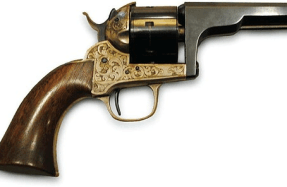CAPTIAL PROTECTION

O SPOT ALONG THE POTOMAC RIVER TRIGGERED MORE ANGST FOR UNION OFFICIALS IN THE SPRING AND SUMMER OF 1861 THAN VIRGINIA’S MATHIAS POINT, a promontory jutting well into the river about 30 miles east of Fredericksburg. At Mathias Point, the Potomac takes a very sharp turn—nearly 270 degrees—and narrows to less than a mile, compelling larger boats traveling up and down the river to abruptly adjust their courses. During the Civil War, that meant that each vessel could become a target for Confederate riflemen or shore batteries lining the channel, threatening to close the river to military and commercial traffic. Rising 20 feet above the river and covered with a dense layer of trees and brush, Mathias Point was a perfect place for the Confederates to conceal troops or a battery of heavy guns ready to wreak havoc on Union ships attempting to pass. ¶ The vitality of the Union capital, already perched perilously between Confederate Virginia and Confederate-leaning Southern Maryland, depended on the free flow of commerce. And in those early months of the war, Commander James Harmon Ward of the neophyte Potomac Flotilla determined uninterrupted ship traffic could never be ensured unless Mathias Point and several other Confederate strongholds below Washington were brought under Union control. ¶ At Mathias Point, Major Thomas Williamson, chief engineer of Virginia state forces, had been pushing for installation of a 10-gun battery but was prevented from doing so by President Jefferson Davis’ senior military adviser, Robert E. Lee, who was worried the point was too vulnerable to a Union land attack. ¶ In late May and early June, Ward’s flotilla had been unable to defeat the Confederate defenses at Aquia Creek, 40 miles below Washington, so Ward turned his attention farther downriver. Even though he was denied the assistance of Union infantry, the 55-year-old commander remained undeterred, and on June 27 he was ready to launch an assault on Mathias Point.
You’re reading a preview, subscribe to read more.
Start your free 30 days





